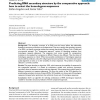Free Online Productivity Tools
i2Speak
i2Symbol
i2OCR
iTex2Img
iWeb2Print
iWeb2Shot
i2Type
iPdf2Split
iPdf2Merge
i2Bopomofo
i2Arabic
i2Style
i2Image
i2PDF
iLatex2Rtf
Sci2ools
BMCBI
2007
2007
Predicting RNA secondary structure by the comparative approach: how to select the homologous sequences
Background: The secondary structure of an RNA must be known before the relationship between its structure and function can be determined. One way to predict the secondary structure of an RNA is to identify covarying residues that maintain the pairings (Watson-Crick, Wobble and non-canonical pairings). This "comparative approach" consists of identifying mutations from homologous sequence alignments. The sequences must covary enough for compensatory mutations to be revealed, but comparison is difficult if they are too different. Thus the choice of homologous sequences is critical. While many possible combinations of homologous sequences may be used for prediction, only a few will give good structure predictions. This can be due to poor quality alignment in stems or to the variability of certain sequences. This problem of sequence selection is currently unsolved. Results: This paper describes an algorithm, SSCA, which measures the suitability of sequences for the comparative ap...
| Added | 09 Dec 2010 |
| Updated | 09 Dec 2010 |
| Type | Journal |
| Year | 2007 |
| Where | BMCBI |
| Authors | Stefan Engelen, Fariza Tahi |
Comments (0)

